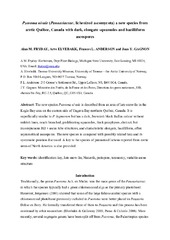| dc.contributor.author | Fryday, A.F. | |
| dc.contributor.author | Elvebakk, Arve | |
| dc.contributor.author | Anderson, F.L. | |
| dc.contributor.author | Gagnon, J.Y. | |
| dc.date.accessioned | 2020-04-17T13:24:32Z | |
| dc.date.available | 2020-04-17T13:24:32Z | |
| dc.date.issued | 2019-01-04 | |
| dc.description.abstract | The new species Psoroma nivale is described from an area of late snow-lie in the Keglo Bay area on the eastern side of Ungava Bay, northern Québec, Canada. It is superficially similar to P. hypnorum but has a dark, brownish black thallus colour without reddish hues, much-branched, proliferating squamules, thick paraphyses, distinct but inconspicuous IKI+ ascus tube structures, and characteristic elongate, bacilliform, often asymmetrical ascospores. The new species is compared with possible related taxa and its systematic position discussed. A key to the species of pannarioid lichens reported from arctic areas of North America is also provided. | en_US |
| dc.identifier.citation | Fryday, A.M.; Elvebakk, A.; Anderson, F.L.; Gagnon, J.Y. (2019) Psoroma nivale (Pannariaceae, lichenized Ascomycota) a New species with dark, elongate squamules and bacilliform ascospores from arctic Québec, Canada.. <i>The Lichenologist, 51, </i>(5), 419-429. | en_US |
| dc.identifier.cristinID | FRIDAID 1776006 | |
| dc.identifier.doi | 10.1017/S0024282919000288 | |
| dc.identifier.issn | 0024-2829 | |
| dc.identifier.issn | 1096-1135 | |
| dc.identifier.uri | https://hdl.handle.net/10037/18052 | |
| dc.language.iso | eng | en_US |
| dc.publisher | Cambridge University Press | en_US |
| dc.relation.journal | The Lichenologist | |
| dc.rights.accessRights | openAccess | en_US |
| dc.rights.holder | © British Lichen Society 2019 | en_US |
| dc.subject | VDP::Mathematics and natural science: 400::Zoology and botany: 480 | en_US |
| dc.subject | VDP::Matematikk og Naturvitenskap: 400::Zoologiske og botaniske fag: 480 | en_US |
| dc.title | Psoroma nivale (Pannariaceae, lichenized Ascomycota) a New species with dark, elongate squamules and bacilliform ascospores from arctic Québec, Canada. | en_US |
| dc.type.version | acceptedVersion | en_US |
| dc.type | Journal article | en_US |
| dc.type | Tidsskriftartikkel | en_US |
| dc.type | Peer reviewed | en_US |


 English
English norsk
norsk